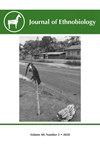Overview and Investigation of Australian Aboriginal Lizard Traps
IF 1.3
3区 社会学
Q1 ANTHROPOLOGY
引用次数: 0
Abstract
Abstract. Landscape management by First Nations Peoples often involves sustainably enhancing environments to increase availability of resources. Granite outcrops, globally, can exhibit such modifications. Propped-up rock slabs constructed by First Nations Peoples for catching reptiles (lizard traps) are a widespread, overlooked, and threatened cultural component of granites of the Southwest Australian Floristic Region. Our team, which includes three Merningar/Menang Elders (co-authors LK, HC, and AE), has undertaken a systematic and culturally informed review of the current scientific literature and Traditional Ecological Knowledge with the subsequent aim of using that data to raise awareness and advocate for lizard trap protection. We collated information and identified knowledge gaps regarding lizard traps: their definition, function, distribution, related Traditional Ecological Knowledge, threats, and conservation. Elders explained that lizard traps do not restrain or contain animals. They provide reptiles with shelter from aerial predators, and opportunities for basking, shade, and foraging. They work as a trap because startled reptiles run beneath a lizard trap, are surrounded by people, and extracted. All 317 published lizard trap records are in southwest Western Australia, across Noongar, Yamaji, and Ngadju lands. Ten papers expressed concern over threats to lizard traps. Overall, lizard traps highlight how sustainable ecosystem enhancement requires deep knowledge of the land and culture that is embedded in the ecological system. Further cross-cultural ecological studies are required to document, understand, and protect these culturally significant structures, and the Traditional Ecological Knowledge and biodiversity that they sustain.澳大利亚土著捕蜥器概述与调查
摘要第一民族的景观管理通常涉及可持续地改善环境,以增加资源的可用性。在全球范围内,花岗岩露头可以表现出这种变化。由第一民族建造的用来捕捉爬行动物(蜥蜴陷阱)的支撑岩板是澳大利亚西南植物区花岗岩中广泛存在的、被忽视的、受到威胁的文化组成部分。我们的团队包括三位Merningar/Menang长老(共同作者LK, HC和AE),他们对当前的科学文献和传统生态知识进行了系统和文化知情的审查,随后的目的是利用这些数据提高人们对蜥蜴陷阱保护的认识和倡导。我们整理了有关蜥蜴陷阱的信息,并确定了它们的定义、功能、分布、相关的传统生态知识、威胁和保护方面的知识空白。长老们解释说,蜥蜴陷阱不会限制或禁锢动物。它们为爬行动物提供了躲避空中捕食者的庇护所,也为它们提供了晒太阳、遮荫和觅食的机会。它们是一种陷阱,因为受惊的爬行动物会跑到蜥蜴陷阱下面,被人包围,然后被抓出来。所有公布的317条蜥蜴陷阱记录都在西澳大利亚西南部,横跨Noongar, Yamaji和Ngadju地区。10家报纸对捕蜥器面临的威胁表示担忧。总的来说,捕蜥器突出了可持续的生态系统增强需要对生态系统中嵌入的土地和文化有深入的了解。需要进一步的跨文化生态研究来记录、理解和保护这些具有文化意义的结构,以及它们所维持的传统生态知识和生物多样性。
本文章由计算机程序翻译,如有差异,请以英文原文为准。
求助全文
约1分钟内获得全文
求助全文
来源期刊

Journal of Ethnobiology
Social Sciences-Anthropology
CiteScore
4.80
自引率
3.40%
发文量
21
审稿时长
>12 weeks
期刊介绍:
JoE’s readership is as wide and diverse as ethnobiology itself, with readers spanning from both the natural and social sciences. Not surprisingly, a glance at the papers published in the Journal reveals the depth and breadth of topics, extending from studies in archaeology and the origins of agriculture, to folk classification systems, to food composition, plants, birds, mammals, fungi and everything in between.
Research areas published in JoE include but are not limited to neo- and paleo-ethnobiology, zooarchaeology, ethnobotany, ethnozoology, ethnopharmacology, ethnoecology, linguistic ethnobiology, human paleoecology, and many other related fields of study within anthropology and biology, such as taxonomy, conservation biology, ethnography, political ecology, and cognitive and cultural anthropology.
JoE does not limit itself to a single perspective, approach or discipline, but seeks to represent the full spectrum and wide diversity of the field of ethnobiology, including cognitive, symbolic, linguistic, ecological, and economic aspects of human interactions with our living world. Articles that significantly advance ethnobiological theory and/or methodology are particularly welcome, as well as studies bridging across disciplines and knowledge systems. JoE does not publish uncontextualized data such as species lists; appropriate submissions must elaborate on the ethnobiological context of findings.
 求助内容:
求助内容: 应助结果提醒方式:
应助结果提醒方式:


